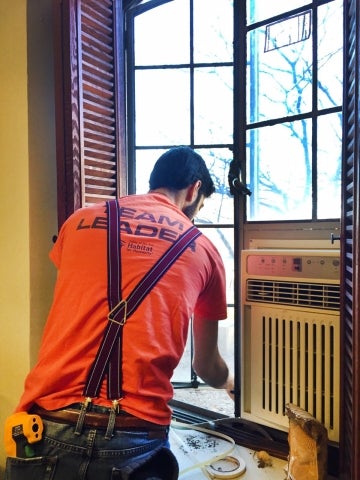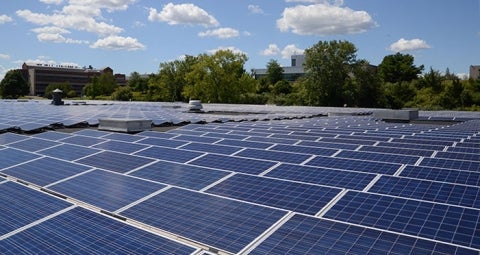Note: Yale School of the Environment (YSE) was formerly known as the Yale School of Forestry & Environmental Studies (F&ES). News articles and events posted prior to July 1, 2020 refer to the School's name at that time.
Yale’s ambitious new carbon pricing experiment will have departments across campus re-thinking energy decisions big and small over the next six months. At F&ES, one of the participants in the pilot project, this is nothing new.
Of course nothing typifies this long-term commitment to energy efficiency more than Kroon Hall, the administrative home of the School and the first LEED-certified building on the Yale campus. When Kroon opened in 2009, School officials wanted it to be more than just a symbol; they wanted it to achieve energy savings and set an example of sustainability for the entire university.
Of course nothing typifies this long-term commitment to energy efficiency more than Kroon Hall, the administrative home of the School and the first LEED-certified building on the Yale campus. When Kroon opened in 2009, School officials wanted it to be more than just a symbol; they wanted it to achieve energy savings and set an example of sustainability for the entire university.
 James Ball, a member of the F&ES Environmental Stewardship Committee, weatherproofs a window in Sage Hall.
James Ball, a member of the F&ES Environmental Stewardship Committee, weatherproofs a window in Sage Hall.
Indeed the building consumes about 60 percent less energy compared to others of its size and, on average, uses less energy per square foot any other building on the Yale campus. School administrators regularly monitor energy data down to the floor- and systems-levels and meet monthly with the Yale facilities department to review any anomalies and upcoming scheduling.
But beyond Kroon, principles of sustainability are embedded in the daily activities of individuals across F&ES. Perhaps nothing reflects this more than the efforts of the student-run Environmental Stewardship Committee (ESC), which explores ways that F&ES can improve its performance when it comes to energy efficiency and material usage.
“The Environmental Stewardship Committee is doing energy efficiency improvements all the time,” said James Ball ’16 M.E.M., a second-year student and member of the ESC. “F&ES is not new to this. We have the most energy-efficient building on campus, and we have the academic expertise, too.”
Still there are plenty of steps that can be taken to improve energy efficiency at F&ES. And in many cases, it comes back to the behavior of community members. For example, Kroon’s energy performance relies heavily on simple actions such as closing windows when the building’s red lights are on, switching off computers at night, and occupant understanding of how to use the different thermostats.
But beyond Kroon, principles of sustainability are embedded in the daily activities of individuals across F&ES. Perhaps nothing reflects this more than the efforts of the student-run Environmental Stewardship Committee (ESC), which explores ways that F&ES can improve its performance when it comes to energy efficiency and material usage.
“The Environmental Stewardship Committee is doing energy efficiency improvements all the time,” said James Ball ’16 M.E.M., a second-year student and member of the ESC. “F&ES is not new to this. We have the most energy-efficient building on campus, and we have the academic expertise, too.”
Still there are plenty of steps that can be taken to improve energy efficiency at F&ES. And in many cases, it comes back to the behavior of community members. For example, Kroon’s energy performance relies heavily on simple actions such as closing windows when the building’s red lights are on, switching off computers at night, and occupant understanding of how to use the different thermostats.
Related Story
 <h4> <a href="/news/article/yale-carbon-charge-plan-offers-new-research-and-outreach-opportunities">Yale Carbon Charge Plan Offers New Research and Outreach Opportunities</a></h4><p> This month Yale embarked on a six-month pilot program that will examine the effect of four different carbon-pricing models of several university buildings, including Kroon Hall. At F&ES, school leaders see it as an opportunity to expand research, student learning, and outreach on a critical energy issue.<br /> <br /> <a href="/news/article/yale-carbon-charge-plan-offers-new-research-and-outreach-opportunities">Read more</a></p>
<h4> <a href="/news/article/yale-carbon-charge-plan-offers-new-research-and-outreach-opportunities">Yale Carbon Charge Plan Offers New Research and Outreach Opportunities</a></h4><p> This month Yale embarked on a six-month pilot program that will examine the effect of four different carbon-pricing models of several university buildings, including Kroon Hall. At F&ES, school leaders see it as an opportunity to expand research, student learning, and outreach on a critical energy issue.<br /> <br /> <a href="/news/article/yale-carbon-charge-plan-offers-new-research-and-outreach-opportunities">Read more</a></p>
Earlier this week, an ESC student team visited offices across F&ES to seal air leaks in windows, check heating and cooling systems, and offer advice for winter break preparations. The ESC and School administrators will provide more energy savings tips to the F&ES community in the coming weeks.
As the wider Yale community heightens its focus on energy usage for the carbon charge project, F&ES has laid the groundwork for what can be done, said Julie Paquette, Director of Energy Management for the Yale Department of Facilities.
“There is that very obvious and important commitment of building Kroon hall,” she said. “But there’s the ongoing commitment of education and training and issue resolution that is a remarkable model for others.”
As the wider Yale community heightens its focus on energy usage for the carbon charge project, F&ES has laid the groundwork for what can be done, said Julie Paquette, Director of Energy Management for the Yale Department of Facilities.
“There is that very obvious and important commitment of building Kroon hall,” she said. “But there’s the ongoing commitment of education and training and issue resolution that is a remarkable model for others.”
– Kevin Dennehy kevin.dennehy@yale.edu 203 436-4842
Published
December 10, 2015